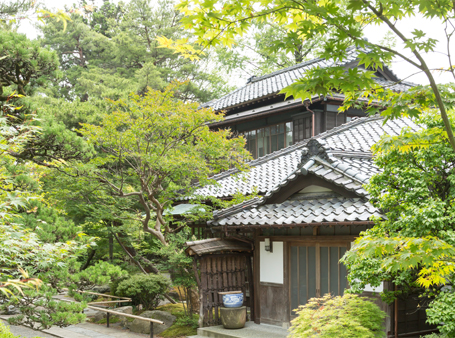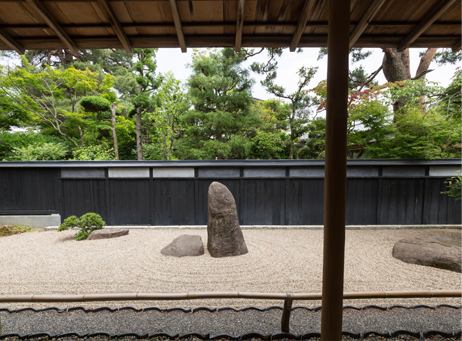
This poem was read by Kaoru Nikaido, the mayor of Shibata city. The garden was named ‘Taikoso’ in comparison to ‘Sekisenso’ (3, Suwa-cho, Shibata, the garden of the former Ishizaki Family). The calligraphy of ‘Taikoso’ was written by Mr. Nikaido.
There are three buildings and each has its own history, allowing you to see them differently and understand them more deeply.
History of Mushatei
It was originally located in the Sannomaru area where the top-ranking officials and the senior officials of Mizoguchi Family, the Lord of the Shibata Clan, resided. It was built as a second house for the Musha family who was known as ‘Gōzoku’, the prominent clan in the Sugatani area, Shibata. Also, it was used as a boarding house for their children who attended a school in town. The original building was extended with the two-storey section in 1925. It is presumed that the one-storey section was built in the early to middle stages of the Meiji period. The calligraphy of ‘Mushatei’ was written by Takashi Musha, the son of the Musha family.


History of Shiunkaku
It was built by the 8th generation, Choei Shirose in 1902. It is said that it was attributable to the great famine in the same year. The shirose family dealt with the famine by offering the same amount of rice in exchange for the amount of soil farmers brought. The family constructed a hill from this soil and saved farmers. Also, they built Shiunkaku and enshrined the Kannon statue to offer their condolences to the dead. Shiunkaku is also said to be ‘the Ginkaku-ji of the Echigo region’.


History of Taishoan
The Murayasu Shoten was famous as the best secondhand clothing dealer in Japan during the Meiji period. The current Taikoso was built as the Murayama family’s second residence to entertain guests, and its garden is one of the finest in Shibata. It is said that Emperor Meiji rested here when he visited the Hokuriku region in 1878. The calligraphy of ‘Taishoan’ was written by a calligrapher, Masumi Okura, a great grandchild of Naomasa Mizoguchi (the 12th lord of the Shibata clan) and Baron Kihachiro Okura (the founder of Okura zaibatsu).




